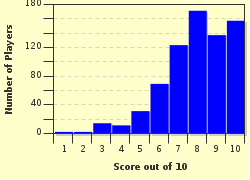Quiz Answer Key and Fun Facts
1. A prehistoric marine predator, the Megalodon could be described as a giant (~20 meters / ~60 feet) long version of this living creature. What is this creature, itself considered a monster thanks to films like "Jaws" (1975)?
2. The Arthropleura was a giant (3 meters / 10 feet) version of what type of many-legged animal?
3. The Meganeura were giant insects with a 3-foot wingspan. What modern insects do they resemble?
4. Not all "monsters" died out millions or even thousands of years ago. The Aepyornis was a large flightless bird of Madagascar that only became extinct in the 17th century. Twice the size of an ostrich, what is the English name for the Aepyornis?
5. The extinct giant rhinoceros, Elasmotherium, was about 6 meters (20 feet) long and had a single horn up to 2 meters (6 feet) in length. Some people think it is the real-life inspiration for what mythological creature?
6. Not quite as big as King Kong, Gigantopithecus were giant (3 meters / 10 feet) versions of what animal?
7. Jaekelopterus rhenaniae was 2.5 meters (8 feet) long and is a "giant sea scorpion", though the name isn't technically correct. Why not?
8. The largest marine reptile found to date is Shonisaurus, which grew to be 21 meters (69 feet) long. What is a distinguishing feature of this creature's mouth?
9. Doedicurus clavicaudatus was 4 meters (13 feet) long and had a bony, spiked tail. It also had an armored carapace like its modern day relative. What animal is related to this creature?
10. Ceratogaulus rhinocerus was a burrowing rodent about 30 centimeters (1 foot) long with what unusual characteristic?
Source: Author
jcpetersen
This quiz was reviewed by FunTrivia editor
crisw before going online.
Any errors found in FunTrivia content are routinely corrected through our feedback system.


